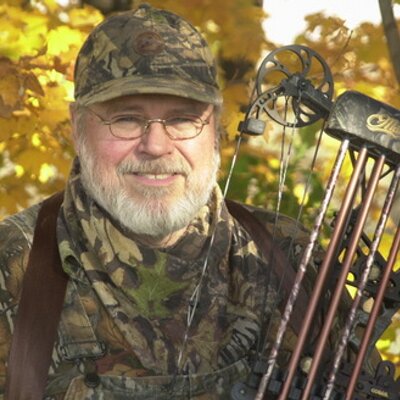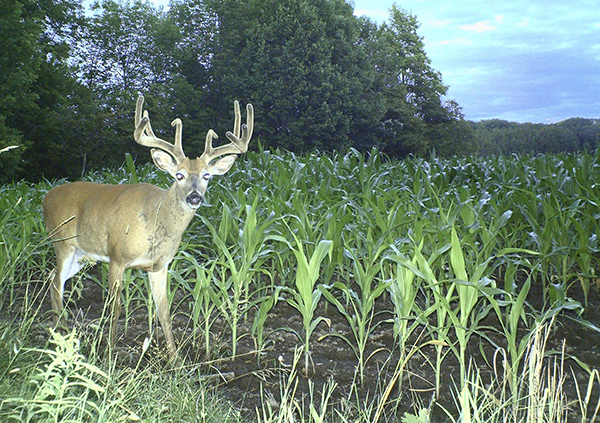Editor’s note: The first article in a three-part series about getting ready for archery deer season.
About this time every year bow hunters start to get excited and anxious about the upcoming deer season.
The signs are everywhere across rural Kentucky that deer season is not that far off: mast is beginning to grow on trees in the woods, fields are lush with clover and tall grass, deer fawns are becoming more visible, and bucks are growing back their antlers with renewed vigor.

When deer season opens deer will still be in their summer pattern, and highly visible while feeding late in the day in fields.
Kentucky’s archery season for deer doesn’t open for 57 days (September 4th this year), but it’s never too early to get organized. Here are some thoughts on pre-season priorities:
• Job one is getting your bow and arrows ready.
For archers who don’t shoot year-round, here are some important to-dos in preparation for the upcoming season.
Take your hunting bow to a trusted technician and have it checked out, top to bottom, especially the bowstring.
A string may look okay, but it may be weakened under the center serving, where the arrow nock or string loop is attached. Bowstrings can also stretch over time and hundreds of shots. A damaged string gets the bow out of tune, so that it shoots erratically and inconsistently.
Make sure your bowstring and serving are waxed. Have worn string loops replaced and inspect your peep sight’s serving.
If you plan to change vital equipment, don’t wait, do it now. It will take weeks to adjust to a new arrow rest or bow sight. It takes longer than you would think to sight in your bow when there’s been a change in equipment.
Inspect arrows carefully. Make sure they are straight and free of cracks. If you have to buy some new arrows, make sure they have the correct spine for your bow’s draw weight and your style of shooting.
Replace damaged fletching or nocks on the arrows you hunted with last year if needed. Be certain that the weight of your field points (practice points) is the same weight as your hunting broadheads.
Set aside one broadhead for practice. As the opening day of archery deer season approaches, sight in your bow with your practice broadhead.
• Look over your treestand, ground blind, and safety harness to make sure none of the parts are worn, and need replacing. If you need new parts, order them now. Don’t wait, avoid the last-minute, pre-season rush.
• Wash all your hunting clothes, air dry outside on a clothesline, then place them in a plastic storage box.
An excellent detergent for hunting clothes is Wildlife Research Center’s Scent Killer Gold. Their autumn formula removes odors and deep cleans your hunting clothing while adding a subtle scent of the forest floor. A 32-ounce bottle retails for $12.99.
• Rubber, slip-on camouflage boots are ideal for bow hunting. They are comfortable, don’t retain human scent and will keep you feet dry if you have to cross a creek.
A good choice is the Lacrosse Burly, an 18-inch boot in Realtree Timber camouflage that retails for $100.
• The digital revolution made it possible for hunters to scout and monitor their hunting area 24 hours a day, with digital scouting cameras, the so-called trail cameras.
If you have never used trail cameras, you might consider buying a few. They are affordable, small, noiseless, powered by AA batteries, and hundreds of high-quality images taken day and night can be stored on a single SD (secure digital) card.
You’ll enjoy monitoring your hunting area, and the odds of taking the wild game you pursue will be greatly increased.
When you place cameras in several locations at once, there’s a better understanding of daily movement patterns. Since cameras can be programmed to provide the date, time and moon phases on images and video, it’s easy to determine the best places to hunt early and late in the day, and where to intercept game as it moves through the property.
Let your hunting property’s size and terrain features dictate the number of cameras employed. Stay away from bedding areas, or areas set aside as “deer sanctuaries” that are never hunted. Place your cameras along the trails leading in and out of these sanctuaries.
When not deployed, store each camera, with its instruction booklet, two SD cards, and extra batteries in a clear, snap-top box for easy transport and quick set-up. Some hunters keep track of the details of camera placement on a notepad or map.
If you have multiple brands of cameras don’t interchange SD cards. There could be SD card format issues. Set aside two SD cards for each camera. If you have several cameras of the same brand, number each camera, using a piece of paper tape and a felt tip pen.
If you plan on putting out trail cameras in the weeks before bow season opens, make sure you have fresh batteries and delete images you don’t want off their SD cards to free up space.
Trail cameras should be mounted about five feet or higher off the ground. Some hunters put a stick between the tree and the back of the camera near its top so that the camera is angled downward slightly. This is a must when cameras are mounted high.
Trees aren’t always where you want them to be when mounting a trail camera, so a metal fence post hammered into the ground is a good alternative.
Be aware of vegetation growing up in front of the camera. In summer weeds grow fast. Tall weeds or hanging tree limbs can trigger the camera when they sway in the wind, draining your batteries and filling up the SD card with pictures of nothing.
Position your camera to protect it from direct sunlight.
Trail cameras facing east (rising sun) or west (setting sun) can be damaged by bright, direct rays of sunlight since their shutters are always open. The ideal set for a camera is to be in dark shade, facing north or south.
When you retrieve an SD card replace it with a blank one. If traveling on foot, don’t visit trail cameras early and late in the day, when deer are most active, to retrieve and replace SD cards.
• Invest in a new foam target, if you need one.
Old targets, with their bullseyes shot out, may allow arrows to pass through the target, damaging arrow fletching or damaging the arrow itself, if it hits a solid object downrange.
Next week: Develop a practice routine to increase accuracy and consistency with your hunting bow.
























